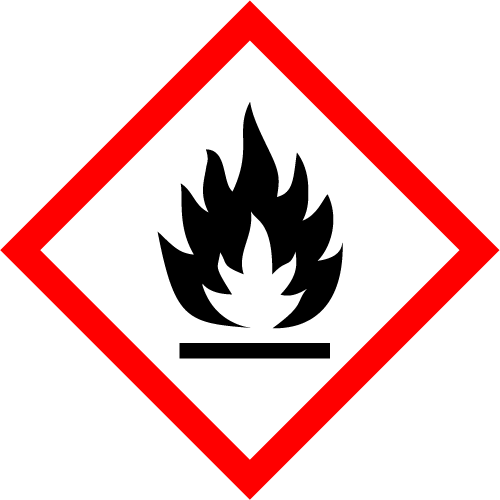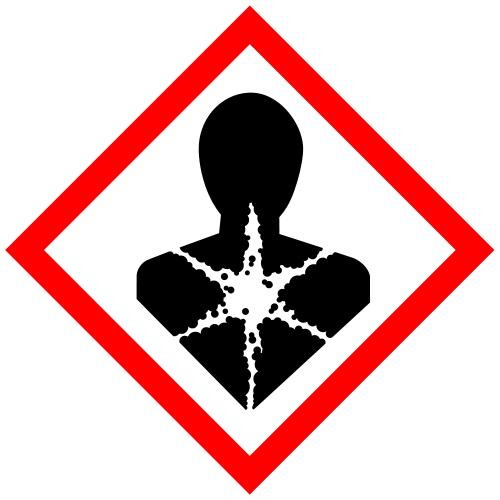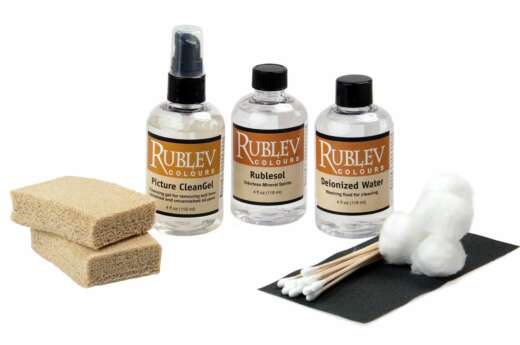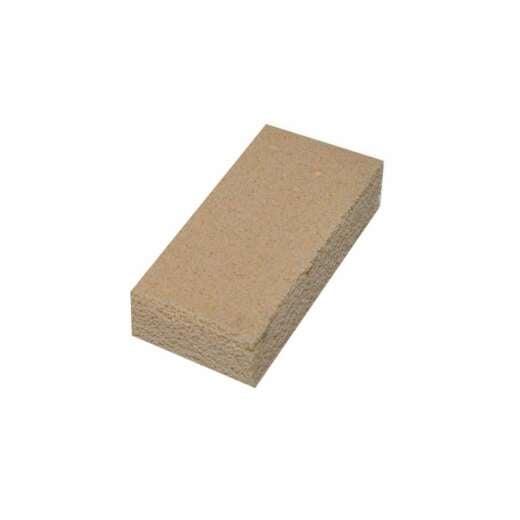Conservar Finishing Varnish
Conservar Finishing Varnish is a colorless, reversible varnish made from hydrogenated hydrocarbon (Regalrez 1094) resin dissolved in pure, low-aromatic solvent and UV stabilizer.
Conservar Finishing Varnish (made by Natural Pigments) is a colorless, reversible varnish made from hydrogenated hydrocarbon (Regalrez 1094) resin dissolved in a pure, low-aromatic solvent and UV light stabilizer. Conservar Finishing Varnish is made according to the original formula developed by E. René de la Rie, formerly of the National Gallery, Washington, D.C. Varnishes based on this formula will not crosslink or yellow over 100 years, as shown by tests conducted at the National Gallery, Washington, D.C.* Conservar achieves optimum wetting of the paint surface to enhance and bring out colors, has a minimum solvent action on paint, and maximum resin content for best coverage. It dries to a film that levels well and can be rubbed when dry, like mastic or dammar varnishes.
* Rene de la Rie and Christopher McGlinchey. 1990. New synthetic resins for picture varnishes. In Cleaning, Retouching and Coatings: Technology and Practice for Easel Paintings and Polychrome Sculpture—Preprints of the Contributions to the Brussels Congress, September 3–7, 1990 (J.S. Mills and P. Smith, eds.) pp. 168–73. International Institute for Conservation of Historic and Artistic Works.
Recommended Uses
Conservar Finishing Varnish is recommended as a final varnish on the following paint films:
Alkyd
Oil
All varnishes work differently on casein, distemper, egg tempera, gouache, and watercolor paintings than on acrylic and oil paint because the varnish is absorbed by the paint and paper, becoming an integral part of the picture that could cause discoloration as the varnish ages. In addition, varnishes on works created using casein, distemper, egg tempera, gouache, and watercolor cannot be removed because they become an integral part of the paint layer.
To varnish casein, distemper, egg tempera, gouache, watercolor, and drawings, apply an isolating coating on the painting or drawing first, then apply a final picture varnish, such as Conservar Finishing Varnish. The final varnish can be removed without damaging the painting or drawing underneath. Remember, however, any isolating coating becomes a permanent part of the artwork since the paint layer absorbs it.
Important: Make a test piece for your application and surface to ensure desired results.
Coverage
A four-fluid-ounce (118 ml) bottle covers approximately 80 square feet (7.4 square meters).
Directions
Before actual use, it is essential to test Conservar varnishes on test pieces to understand how they perform and alter the surface appearance of your paintings. For best results, apply to a test piece similar in composition to the artwork to be varnished. This will help ensure that a successful varnish application will be achieved.
When to Varnish
The best practice is to wait 6 to 12 months before varnishing with Conservar Finishing Varnish. Oil and alkyd paint films need time (typically months) to polymerize and form a resilient film; otherwise, a coating added to an improperly cured film may cause the layers beneath to swell and loosen.
It may be possible to apply Conservar Finishing Varnish when the thickest areas of your painting are dry through—not touch dry. To determine if your painting is “dry-through,” press into the thickest area of your painting with your thumb while twisting it a full 90° on the paint film. If your painting is on a flexible support, such as stretched canvas, support the opposite side. The paint is considered dry-through when no loosening, detachment, wrinkling, or distortion is visible on the paint surface. This procedure is fully described in the ASTM Standard D1640: Standard Test Methods for Drying, Curing, or Film Formation of Organic Coatings at Room Temperature.
Please note, however, that the more the oil paint is allowed to polymerize or cure, the more likely the varnish application will be successful. Always test the application of varnish on test pieces first to determine the suitability of the varnish for your application.
Preparation for Varnishing
Acclimate your painting and varnish materials and tools to the same environment. At least several hours before varnishing, place all items, such as your painting, brushes, containers, and Conservar varnish, in the same room. Varnish in a dust-free environment with the least amount of air movement to avoid raising dust.
It is best to brush or spray and apply Conservar varnishes. Other methods, such as applying with paint pads, sponging, or rolling, are not recommended, as they may result in foaming, loss of film clarity, non-uniform coverage, excessive film build, sagging, or deposit of materials from the application tool.
Brush Application
Apply with a wide flat, soft-hair brush. Conservar Finishing Varnish can be thinned up to 20% with odorless mineral spirits. DO NOT MIX WITH WATER. Apply only one coat as a final varnish when applying by brush. Allow to dry for three days, and wipe the varnished surface with a soft, lint-free cloth.
Spray Application
The best way to achieve an even varnish coating is by spraying. This is particularly true for impasto surfaces. Spraying is also a helpful technique for creating a matte surface. The size of the surface to be sprayed will determine the best type of spray equipment to use. Conservar varnishes can be sprayed from an airbrush, airless or air-pressure spray equipment, or a refillable aerosol spray can.
To prepare for spraying, make sure all equipment is free of dirt. Work in an area free of dust and dirt, and keep work off the ground when spraying. Spray two to four light, even coats instead of one or two thicker applications, allowing enough time for drying between coats (1 to 4 hours or until the surface is tack free).
Release the spray trigger when stopping the motion of the sprayer during application to avoid a buildup of varnish in one spot. Maintain a uniform distance from the surface, and avoid spraying in an arcing motion. Make straight passes across the work, changing direction once the spray has cleared the edge of the piece being varnished. Slightly overlap the spray pattern with each pass until the entire passage has been covered.
To achieve a more uniform spray application, turn the painting 90 degrees and apply the subsequent coat perpendicular to the previous one. A typical spray application lays down a film only 1/8 to 1/4 the thickness of a brush coat application. If maximum protection is required of the varnish layer, apply multiple coats.
Drying Time
When applying multiple coats (spray application only), allow 1 to 4 hours between coats. Inspect the surface for tackiness, which may mean the coat is not sufficiently dry. Let the varnish cure for several days before packing or transporting the painting. During transportation and storage, avoid contacting the surface with packing materials, including glassine, bubble wrap, or any other plastic. NEVER STACK PAINTINGS, whether varnished or not.
Care and Storage
As Conservar varnishes are removable, it is essential that they not be painted over. Paint applied over the varnish would also be potentially removable and would pose a complex problem in conservation or restoration attempts.
Techniques for Reducing Gloss
There are several different ways to reduce the gloss of Conservar varnish:
Dilute the varnish with additional solvent before using.
Apply a thin coating. The thinner the coating, the lower the gloss.
Brush the varnish as it dries. When the varnish is starting to set up, if you continue to brush it, you will microscopically roughen the surface and be less glossy.
Spray and apply the varnish.
If the varnished surface of your painting appears too glossy, you can apply a final coating of Conservar Wax. Rub on a thin layer of wax with a soft, lint-free cloth using small circular strokes. Allow the wax to dry overnight for the highest degree of matte. Let the wax dry for 4 to 6 hours to create a satin finish, then gently buff.
Cleanup
Clean all equipment immediately following application—clean brushes with odorless mineral spirits, such as Rublesol.
Removal
Use a clean, soft, lint-free rag dampened with odorless mineral spirits. Gently rub the varnished surface and repeat the process until all varnish is removed. Do not use stronger solvents. Allow to dry and reapply Conservar varnish.
Regalrez is a registered trademark of Eastman. Conservar is a trademark of Natural Pigments. Rublev Colours is a registered trademark of Natural Pigments.
| SKU | 540-31 |
|---|---|
| Brand | Rublev Colours |
| Vendor | Natural Pigments |
| Processing Time | Usually ships the next business day. |
| Resin Type | Regalrez |
Hazard Pictograms
 |  |  |
| GHS09: Flammable | GHS08: Health Hazard | GHS07: Exclamation Mark |
Signal Word: Danger
Hazardous Components
Distillates (petroleum), hydrotreated light
Hazard Statements
Flammable liquid and vapor.
Causes skin irritation.
Causes serious eye irritation.
May cause genetic defects.
May cause cancer.
May cause respiratory irritation.
May be fatal if swallowed and enters airways.
Precautionary Statements
If medical advice is needed, have product container or label at hand.
Keep out of reach of children.
Read label before use.
Keep away from heat/sparks/open flames/hot surfaces. No smoking.
IF SWALLOWED: Do NOT induce vomiting. Immediately call a POISON CENTER or a physician.
IF ON SKIN (or hair): Immediately take off all contaminated clothing. Rinse skin with water.
IF INHALED: Remove person to fresh air and keep comfortable for breathing. Call a POISON CENTER or a physician if you feel unwell.
IF IN EYES: Rinse cautiously with water for several minutes. Remove contact lenses, if present and easy to do. Continue rinsing.
Conforms to ASTM D4236.







